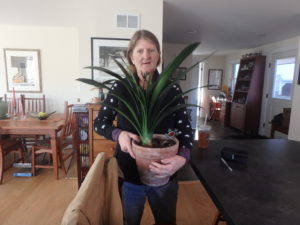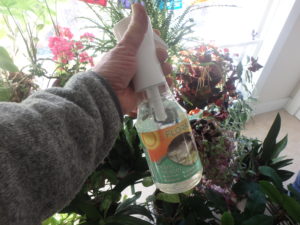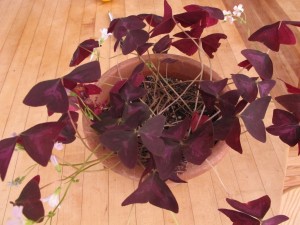Houseplants: How to Keep Them Happy and Healthy
I recently visited my friend Alicia Jenks of Green Dragon Farm in Weathersfield, Vermont, to take a look at her houseplants – some 50 or more of them. Alicia considers them her “indoor garden’, her plant friends that keep her gardening all winter. She doesn’t think houseplants are hard to maintain, but asserts, “You have to pay attention to them. They can’t take care of themselves.” Good point.
Alicia does not put her houseplants outside in the summer. Instead she keeps them on a covered screen porch. This allows her to regulate how much water they get, keeps them away from pests like earwigs, and keeps them from getting sun scald.
Before she brings them into the house in September, Alicia gives her houseplants a good gentle shower – outdoors, with a hose. Aphids and other pests can often be knocked off with a stream of water, avoiding the need to use a soap solution to kill them later. Of course you must get the underside of leaves, too, and rinse the surface of the potting soil, too.
Alicia keeps her best, most luscious houseplants in the living-dining area. Her Junior Varsity team she keeps upstairs in a spare room. The rest, the Club Squad, stay in the basement under lights. She gives each the same care, and any plant can get upgraded to the living room. All it needs to do is bloom.
Water, too much or too little, is what kills most houseplants. Alicia does not follow a set schedule such as watering every Sunday, though that works for many people. Instead she regularly checks her plants by placing a finger on the soil surface. If it is lightly moist, she does not water. If it is dry, or if the leaves are losing some of their turgidity and wilting, she waters.
Alicia gives a deep watering each time she waters, enough so that a little water will seep through the pot’s holes in the bottom and into the saucer it sits on. In the summer when it is hot, she might have to water some plants every 2 to 3 days. In winter once a week may be enough.
What about fertilizer? Alicia gives some liquid fish emulsion fertilizer once a month from April to September. Fish or seaweed fertilizers are good for houseplants because they have a wide variety of nutrients, including many micronutrients that are not found in chemical fertilizers. During the winter? Most plants are not doing much growth then and should not be fertilized, she told me.
Most houseplants do not need much direct sunshine. Before you buy a houseplant, read the tag to see what it needs. Bright indoor sunlight is fine for most plants. Cyclamen, begonias, Christmas cactus, poinsettias, oxalis and many others will do well in a brightly lit room, without direct sunshine.
I have read that the direct sunshine diminishes exponentially with the distance from the glass. That means that sunshine two feet from the glass is 4 times weaker than sunshine a foot from the window, and at 3 feet away, it is 9 times weaker. Keep that in mind when you place a plant. Rosemary, which appreciates strong sun, should be as near the window as possible – without touching it. No plant leaves should touch the glass in winter.
Books and websites are full of advice. Still, I find the very best information about houseplants is found in my 1969 edition of Thalassa Cruso’s book, Making Things Grow: A Practical Guide for the Indoor Gardener. Although this book was written nearly 50 years ago and is long out of print, I have never visited a used bookstore that didn’t have it. And it is available on-line.
What I like about Ms. Cruso’s book is the practical nature of it. It covers pretty much any houseplant you can buy. She has grown it, figured out what makes it happy, and will save you the trouble of experimenting – and killing- houseplants yourself. Plus, her writing is easy to follow – and sweet.
Success is often in the details. Take those bright red zonal geraniums we often grow in pots in summer to adorn a sunny location. Did you know that they do best when their potting mixture is well patted down in the pot, compressing it? I didn’t. Or that geraniums can be made to flower beautifully indoors in winter by pinching them back regularly in summer, frustrating their attempts to blossom until winter? Ms. Cruso taught me that.
Alicia Jenks does not re-pot her plants very often. She believes that many bloom better if the roots are a little crowded, but if the roots are pushing out the top or through the drainage hole, it might be necessary.
Thalassa Cruso warns against “potting on’ a root-bound plant into a much larger pot. She explains that using a pot more than an inch in diameter larger than the pot a plant is growing in can cause root rot. Why? The excess soil material will not easily dry out – because the roots will not reach it.
I never think of myself as a houseplant kind of guy, though when I counted up my houseplants for this article I saw I had 43 plants, including a Crown of Thorns that is over 100 years old, a banana tree, a fig, an 8-foot hibiscus and an even bigger frangipane tree that bloomed all last winter!
Henry is away, and will not be answering e-mail this week. His website is Gardening-Guy.com. He is the author of 4 gardening books.
The Irish Gardener
My great-grandmother took the boat from Ireland to Boston in the latter part of the 1800’s. Dobbie, as we called her, got a job as a cook at Wellesley College. That was a bit ironic because she was, in my memory, a wonderful person but a horrible cook. She never made me anything that I can recall eating with pleasure. Even her boiled eggs – usually a favorite of mine- were runny and disgusting.
So, despite the fact that I am one quarter Irish, for a long time I never paid much attention to Irish food. Not so any more. With St Paddy’s day just around the corner, I will soon be cooking up a big pot of colcannon, one of the great comfort foods of all time. It’s a wonderful combination of potatoes and kale – foods that I still have from last summer’s garden.
As a gardener and a chef I appreciate the value of potatoes, especially potatoes from my own garden. Potatoes come in as many colors and flavors as tomatoes. I grow potatoes with flesh that is white, yellow, pink and purple. I store and save potatoes, and once I went about 20 years without buying a potato to eat or plant. I just started this year’s planting with last year’s potatoes and I stopped eating potatoes when I ran out – until the next crop came in.
But back to colcannon. It is a potato dish I always eat on St. Patrick’s Day. It is easy to make and tasty to eat. I generally use a white potato such as the Kennebec, which is also my most productive variety. One chunk of potato planted can yield up to 5 pounds of potatoes.! They grow big and are great for mashing. The other main vegetable in colcannon is kale, which I grow in quantity and freeze for winter use. I like a variety called Winterbor which is readily available by seed or as seedlings at your local garden center. Here’s how to make a nice Irish side dish:
Ingredients:
2-3lbs of white potatoes
5-6 Tablespoons butter
3 cups kale, fresh or frozen, chopped finely & lightly packed in a measuring cup
½ cup onion finely chopped, or 3 green onions (including the greens)
1 cup whole milk or light cream
Method:
- Peel and boil the potatoes until they will fall apart when poked with a fork.
Drain. - Sauté onions and kale in the butter in a heavy pot on medium heat for 3 to 5 minutes.
- Add potatoes, stir.
- Add the milk (or cream for sheer decadence) and mash well using an old fashioned potato masher, not an electric mixer.
- Add salt and pepper as desired.
But on with the Irish theme. The rest of the meal should be Guinness stew, but that’s not from my garden, so you’re on your own for that. But as a centerpiece on St Patrick’s Day there should be a plant that screams “Irish”. The shamrock? The true Irish shamrock is a type of clover (Trifolium dubium) that is very hard to grow indoors and is rarely available even from florists and nurseries. What you can grow as a house plant is a type of wood sorrel commonly called oxalis. It looks like the Hallmark version of a shamrock.
Oxalis is a nice house plant that comes in green and maroon-leafed varieties – though for St Patrick’s Day green is the proper selection. There are some 300 species of oxalis. Mine do well in a bright window – I have 2 of the maroon-leafed ones in bloom right now. In the summer they thrive on my somewhat shady deck. The light pink flowers are small and reach up above the leaves on thin stems. The leaves fold up at night time.
One of the great things about oxalis is that it is nearly impossible to kill by under-watering it. The leaves may shrivel up and die off, but if this happens, just give it a rest –which I have read it likes – and it will bounce back when you start watering it a few weeks later.
If you have an oxalis, you can divide it easily by separating the corms (the thickened roots) and planting pieces of them in new pots with fresh planting medium. Like most houseplants, oxalis does not do well if the roots stay constantly wet. I have planted mine in potting soil enriched with compost. I find a 50-50 mix is good. I have learned to judge dryness of the soil by lifting the pot. The surface may look dry, but if the pot is heavy there is still plenty of moisture down below.
Whether you have some Irish in you or not, grow potatoes and kale this year. Both are supremely easy. But it’s too cold to think about that now – except as ingredients in colcannon. Bon appétit!
Henry Homeyer is the author of 4 gardening books and a children’s fantasy-adventure about a boy and a cougar. His Web site is www.Gardening-guy.com.







